
Peering down from atop Mount Olorgesailie, one can see a panoramic expanse of arid, open land, broken with hills, valleys and some pockets or narrow swaths of green vegetation. It is, like many parts in this region of Africa, not atypical. Standing at lower elevations, where the mountain looms above, one encounters open, rocky areas, with tall hills naked of any vegetation, and even some sparse, bushy woodland landscapes more typical of the savannah. Some spaces feature massive boulders rising from the earth—remnants of an ancient flood. Mount Olorgesailie, and its much larger context known to geographers and geologists as the Olorgesailie Basin, lies within the immense but narrowly defined East African Rift system, an active continental rift zone where the greater African Tectonic Plate is actually splitting apart, like dividing cells, into two new plates—the Somali Plate and the Nubian Plate—destined to create a new ocean. It all began about 22-25 million years ago at the onset of the Miocene, an Epoch when many new species emerged, including our own superfamily, the great apes.
The Handaxe People
This stark yet beautiful landscape and its assortment of wildlife have been attractors for thousands of visitors over the decades. Some of these visitors have been scientists, specialists like geologists, paleoanthropologists, paleontologists, and others, and few of the region’s features have attracted these specialists more than the exposed layers of ancient sediments the active geology of the region has created over the millennia. One of those specialists is Rick Potts. Educated at Harvard University, Potts has spent much of his career as an academic and administrator, having taught at Yale University and curated archaeological/anthropological materials at Yale’s Peabody Museum. He now serves as the director of the Smithsonian’s Human Origins Program and curator of anthropology at the National Museum of Natural History. When he’s not attending to his program and curatorial duties, however, he is in the field, along with teams of other scientists, at locations in the East African Rift Valley or in southern and northern China. He has spent decades directing and conducting research in the Olorgesailie Basin, where he and his colleagues have unearthed and identified evidence within the sediments describing an ancient world documented back 1.5 million years — a world of extinct animals, ancient lakes and other water systems, geologic events, and, perhaps most significantly for the purposes of this writing, hominins — human-like creatures thought by many scientists to be ancestral to humans today. Potts is arguably best known for directing research and excavations beginning in the 1980’s, under the auspices of the Smithsonian’s Human Origins Program and the Department of Earth Sciences of the National Museums of Kenya. Here in the Olorgesailie Basin he and his colleagues have helped to further inform what we know about an area that has yielded one of the largest collections of Acheulean stone handaxes ever uncovered in any single location. Numbering in the thousands, the handaxes and their associated stone leftovers from the toolmaking process, and other bifacial tools, have been dated to over 900,000 years ago by applying single-crystal argon-40 and argon-39 and paleomagnetic dating methods. Ancient Pleistocene Epoch active volcanism in the region has been a major key here, as quantities of the argon radioactive isotopes have been trapped inside volcanic particles (now present in the sediments) following eruptions. By measuring the decay of this radioactive material over time, scientists have been able to determine with reasonable accuracy the time range of the sediments in which the handaxes and other artifacts were found. These same sediments have also recorded when the Earth’s magnetic pole reversed direction, specifically around 992,000 years ago and then 790,000 years ago, framing the time and helping to confirm the dates.
________________________________
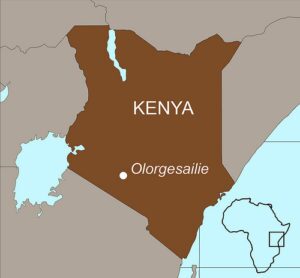
Evidence for milestones in human evolution was found in the Olorgesailie Basin in southern Kenya, which holds an archaeological record of early human life spanning more than a million years. From news release article, Scientists discover evidence of early human innovation, pushing back evolutionary timeline, March 17, 2018. Human Origins Program, Smithsonian
_________________________________
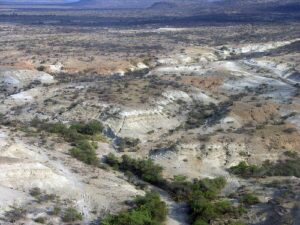
A bird’s eye view of the Olorgesailie Basin in southern Kenya, which holds an archeological record of early human life spanning more than a million years.From news release article, Scientists discover evidence of early human innovation, pushing back evolutionary timeline, March 17, 2018. Human Origins Program, Smithsonian
____________________________________
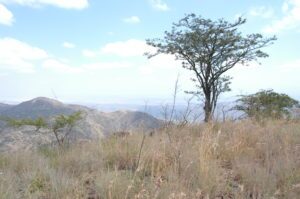
View of the Olorgesailie Basin from atop Mount Olorgesailie. Courtesy Briana Pobiner
__________________________________
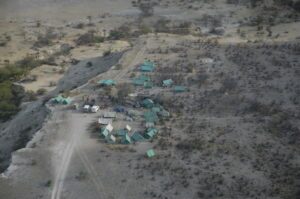
Aerial view of the Olorgesailie field camp during field work in 2005. Courtesy Briana Pobiner
_____________________________________
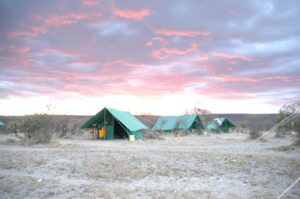
Sunset over the field camp in 2005. Courtesy Briana Pobiner
__________________________________
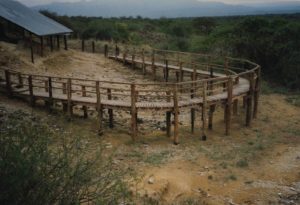
Above and below: Olorgesailie features a massive assemblage of Acheulean stone tools, and is well known for its handaxes. Rossignol Benoit, Wikimedia Commons
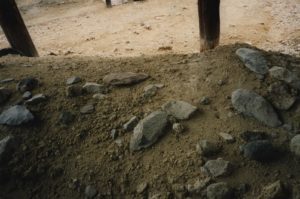
____________________________________
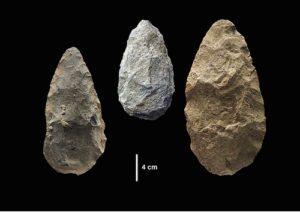
Olorgesailie handaxes. Handaxes are thought to be the longest used stone tool in prehistory, possibly used for multiple purposes, including butchering animals, digging for tubers, chopping wood and removing tree bark, throwing at prey, and as a source for flake tools.From news release article, Scientists discover evidence of early human innovation, pushing back evolutionary timeline, March 17, 2018. The National Museums of Kenya loaned the artifacts pictured above to conduct the analyses published in Science. Human Origins Program, Smithsonian
_________________________________
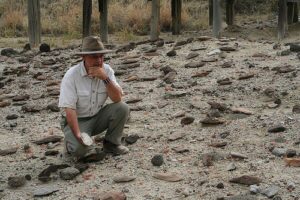
Rick Potts, director of the National Museum of Natural History’s Human Origins Program at the Smithsonian and leader of the Olorgesailie excavations. Above, he surveys an assortment of Early Stone Age handaxes discovered in the Olorgesailie Basin, Kenya. From news release article, Scientists discover evidence of early human innovation, pushing back evolutionary timeline, March 17, 2018. Courtesy of Jason Nichols.
________________________________
The presence and age of the stone tools have been fascinating enough, but the million-dollar question remains: Who were the makers of these stone artifacts? Potts and colleagues suggest they may have been members of the Homo erectus species. They cite several reasons for this: Based on the archaeological and fossil record, Homo erectus has been typically associated with Acheulean handaxe technology. Secondly, the dates of the sediments in which the Olorgesailie handaxes were found (around 990,000 years ago) fall squarely within the date-range in which Homo erectus lived in Africa. And thirdly, hominin fossils making up a partial braincase bearing characteristics that could be assigned to Homo erectus were found at Olorgesailie in 2003. Those finds were recovered from sediments dated to around 900,000 years ago. Moreover, the remains were found about 1.5 km east of a large grouping of Acheulean handaxes, which were associated with the same sediment layer as the fossil finds.
_________________________________
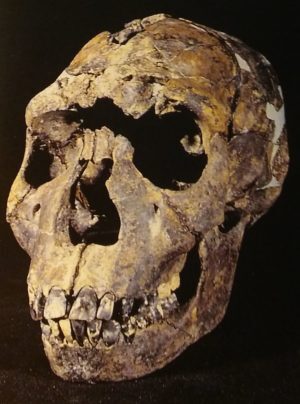 Homo erectus (or Homo ergaster, thought by some scientists to be its African version) was the first global hominin, as fossil remains have been found in Africa (east, north and south), West Asia, and East Asia. Having persisted a remarkable 1.75 million years, from 1.89 to 143,000 years ago, it is also the first hominin to feature more modern human-like body proportions, in particular its ‘un-apelike’ elongated legs and shorter arms relative to the torso, as well as a larger braincase in comparison to other, earlier hominins. A classic example of the African Homo erectus is embodied in the famous “Turkana Boy” find, (the fossil skull shown here), a 40% complete fossil skeleton unearthed in 1984 at Nariokotome in West Turkana, Kenya and dated to about 1.6 million years ago. (Image courtesy Smithsonian Institution, Human Origins Program)
Homo erectus (or Homo ergaster, thought by some scientists to be its African version) was the first global hominin, as fossil remains have been found in Africa (east, north and south), West Asia, and East Asia. Having persisted a remarkable 1.75 million years, from 1.89 to 143,000 years ago, it is also the first hominin to feature more modern human-like body proportions, in particular its ‘un-apelike’ elongated legs and shorter arms relative to the torso, as well as a larger braincase in comparison to other, earlier hominins. A classic example of the African Homo erectus is embodied in the famous “Turkana Boy” find, (the fossil skull shown here), a 40% complete fossil skeleton unearthed in 1984 at Nariokotome in West Turkana, Kenya and dated to about 1.6 million years ago. (Image courtesy Smithsonian Institution, Human Origins Program)
____________________________________
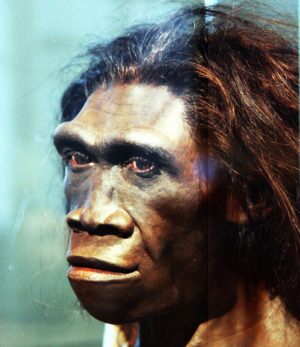
A model of the face of an adult female Homo erectus, one of the first truly human ancestors of modern humans, on display in the Hall of Human Origins in the Smithsonian National Museum of Natural History in Washington, D.C. Reconstruction by John Gurche; photographed by Tim Evanson. Wikimedia Commons
__________________________________________
Whether or not the toolmakers were Homo erectus, the Olorgesailie teams have been able to piece together a general depiction of what these early humans were doing in this place so long ago, and this takes us to several sites in the basin that have shed some interesting evidence that illuminates our understanding of hominin behavior on this ancient landscape.
Surviving at 1 Million BP
This deep into prehistory, it has been comparatively rare to find evidence of human activity. Nonetheless, scientists are encountering a mounting number of instances in Africa and throughout the world that have revealed clues to human behavior before the emergence of Homo sapiens. This is remarkably the case at Olorgesailie. Beginning between 900,000 and 1.2 million years ago in this place, human predecessors have left not only their tools but also the markings of what they were doing with these tools. Investigators have revealed that the Olorgesailie hominins were producing their tools at or near volcanic outcrops in the highlands, as evidenced for example by what has been identified as an ancient quarry worksite about 990,000 years old that yielded thousands of artifacts, most of which were flakes or debitage, but some clearly finished pieces — such as Acheulean handaxes. During investigations in the basin, archaeologists also discovered a smaller percentage of stone tools made from quartzite and obsidian, the sources of which were located 48 km and 18 km respectively away from the basin area where the stone tools were found, suggesting that these hominins traveled to acquire resources, a behavior and capability that would be essential to surviving changes in their environment.
Other finds provided additional evidence of what these hominins acquired and ate for food. A site named ‘Hyena Hill’ yielded stone tools and associated bones that indicated they were cut and even broken open for consumption, and a site that revealed the fossilized bones of an extinct elephant, surrounded by more than 2300 stone artifacts, evidenced consumption by cut marks on one of the elephant’s ribs, some vertebrae and a hyoid bone. Analysis of the artifacts indicated that their material had been transported from at least 17 different source locations and then manufactured at the elephant site, where the artifacts, many of which were sharp blades, were likely used to butcher the elephant. Extension of the excavation to other areas revealed butcheries of zebra and an antelope, as well. Scientists who have examined the site suggest that, at the time the elephant and the other animals were butchered, this was a drying wetlands zone. Were drying wetlands a preferred environment for hominin food acquisition? Scientists theorize this may have been the case at Olorgesailie almost 1 million years ago.
The record for these early hominin handaxe makers came to an end, however, around 490,000 years ago. But this is not the end of the story at Olorgesailie. Research and excavations since 2002 have turned up fascinating new evidence of a human presence that has shed new light on our understanding of the emergence of Homo sapiens — our own species — and a new synthesis for thinking about the elements that have helped shape the nature and direction of human evolution.
Innovating for Success
In March, 2018, researchers published three papers in Science that presented startling new findings bearing on the activities of a very different breed of early humans in the Olorgesailie Basin. Beginning in 2002, scientists led by Potts and colleagues from the Smithsonian Institution, the George Washington University and the National Museums of Kenya began encountering artifacts that differed markedly from the plethora of Acheulean artifacts uncovered in previous years and for which Olorgesailie, to that point, was renowned for decades. These new stone tools were smaller. They were more carefully shaped. They exhibited characteristics of standardizations and innovations that were not present in the earlier technology, such as touched and un-retouched pointed forms, some of them thinned or modified for hafting. There were side and end scrapers, perforators, and notched, denticulate and other retouched forms. Notably, approximately 42% of the accumulated new assemblages consisted of obsidian-made artifacts—a glassy, volcanic material that produces excellent, resilient sharp edges for cutting when worked into useable tools. The fact that this material was present in such quantity is significant at least in part because most of the sources (investigators determined 7 source groups, or locations) were measured to be 25 to 50 km away in five different directions. This meant that the material had to be transported anciently to the locations where they were found by the archaeologists. Further analysis showed that they had to be manufactured, not at their source locations, but at the sites where they were used. Another very significant element discovered among these artifacts revolves around the presence of black (manganese) and red (ochre) iron-rich ore stones in association with the artifacts. Analysis of this material suggested they were used as sources for pigments or coloring material, and that they, like many of the other artifacts, had been transported from their original source locations. “We don’t know what the coloring was used on,” said Potts, “but coloring is often taken by archeologists as the root of complex symbolic communication.”* And like the stone tools, analysis of the sourcing of the pigment stones alluded to the possibility that these humans, unlike their earlier forbears in the basin, had extended social networks and connections across space.
________________________________
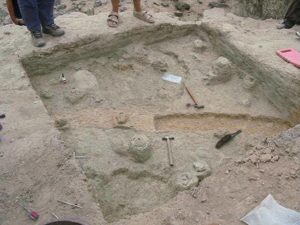
Excavation conducted by Alison Brook’s team at an Olorgesailie Middle Stone Age site.From news release article, Scientists discover evidence of early human innovation, pushing back evolutionary timeline, March 17, 2018. Francesco d’Errico, PACEA (CNRS/ University of Bordeaux/French Ministry of Culture)
_______________________________
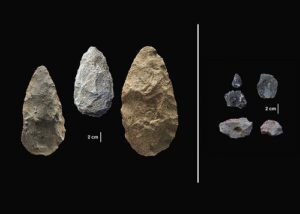
The sophisticated tools (right) were carefully crafted and more specialized than the large, all-purpose handaxes (left). Many were points designed to be attached to a shaft and potentially used as projectile weapons, while others were shaped as scrapers or awls.From news release article, Scientists discover evidence of early human innovation, pushing back evolutionary timeline, March 17, 2018. The National Museums of Kenya loaned the artifacts pictured above to conduct the analyses published in Science. Human Origins Program, Smithsonian
_____________________________
Moreover, the artifacts, including the iron-rich ore stones that may have been used for pigmentation, were much more akin to the types of artifacts found at Middle Stone Age (MSA) sites in other parts of Africa. In terms of dating, such artifacts have generally fallen within the range of 280,000 to about 50,000 years old, and have been associated with the earliest Homo sapiens. Were these artifacts made by archaic modern humans, or Homo sapiens?
Dating the artifacts helped to shed additional light on the question. In the Science paper authored by Alan Deino of the Berkeley Geochronology Center and colleagues, researchers reported using argon-40 and argon-39 isotopic and uranium series dating to calibrate the age of the volcanic deposits in which the artifacts were found. They concluded that the artifacts “began accumulating as early as about 320 ka years ago and terminated by about 295 ka years ago”.**
This meant that these MSA-type artifacts had been produced by hominins during a time when, based on recent discoveries at sites such as Jebel Irhoud*** in northern Africa as well as other sites in Africa, archaic Homo sapiens began to emerge.
The conclusion was nothing less than profound. Now there was evidence that early humans had begun producing their characteristic MSA technology as early as 320,000 years ago in eastern Africa, or at least in the Olorgesailie Basin, tens of thousands of years before previous evidence has indicated so in the region.
Equally important was the composition of the faunal fossil material found in association with the artifacts. According to the research as documented in the Science paper by Alison Brooks of the George Washington University and colleagues, more than 2,000 fossil remains of mammals, reptiles, fish, and birds were recovered from the deposits that featured the artifacts. Common taxa included springbok, equids, suids, kudu, bat-eared fox, springhare, root rat, and an extinct alcelaphine. Many of the remains featured surface markings characteristic of those left by butchering with stone tools, suggesting that these early humans were consuming a wide variety of fauna, and particularly smaller animals, as compared to their more ancient Acheulean counterparts in the basin. Reported Brooks, et al., “the presence of many relatively smaller taxa suggests direct predation by humans rather than scavenging, as small taxa remains are unlikely to survive initial consumption by primary predators.”****
___________________________________________
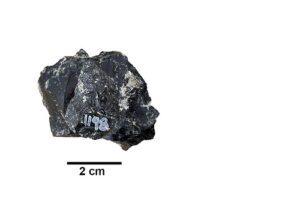
Above and below: The Smithsonian team found small stone points made of non-local obsidian at their Middle Stone Age sites. The team also found larger, unshaped pieces of the sharp-edged volcanic stone at Olorgesailie, which has no obsidian source of its own. The diverse chemical composition of the artifacts matches that of a wide range of obsidian sources in multiple directions 15 to 55 miles away, suggesting exchange networks were in place to move significant quantities of the valuable stone across the ancient landscape.From news release article, Scientists discover evidence of early human innovation, pushing back evolutionary timeline, March 17, 2018. The National Museums of Kenya loaned the materials pictured above to conduct the analyses published in Science. Human Origins Program, Smithsonian
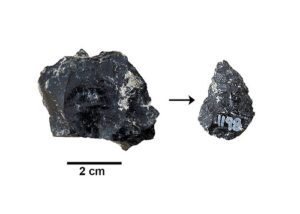
_________________________________
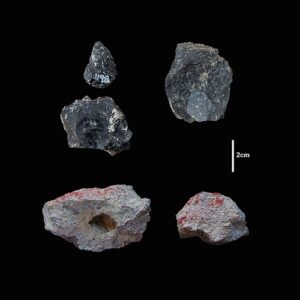
Olorgesailie MSA stonetools and pigment.From news release article, Scientists discover evidence of early human innovation, pushing back evolutionary timeline, March 17, 2018. The National Museums of Kenya loaned the artifacts pictured above to conduct the analyses published in Science. Human Origins Program, Smithsonian
___________________________________
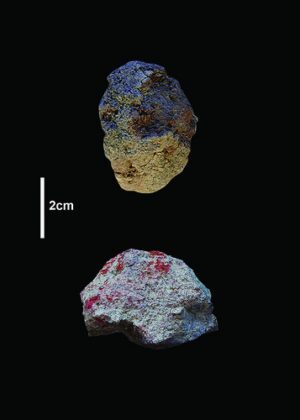
The research team also discovered black and red rocks—manganese and ochre—at the sites, along with evidence that the rocks had been processed for use as coloring material. From news release article, Scientists discover evidence of early human innovation, pushing back evolutionary timeline, March 17, 2018. The National Museums of Kenya loaned the materials pictured above to conduct the analyses published in Science. Human Origins Program, Smithsonian
__________________________________
Advancing Through Adversity
So what do these latest findings say about early humans in the Olorgesailie Basin and human evolution generally?
Summing up some of the biggest takeaways from the Olorgesailie research, the National Center for Scientific Research (CNRS), whose own Francesco d’Errico played a key role in the investigations, reported that “between 295,000 and 320,000 years ago, hominins present in Kenya’s Olorgesailie Basin were already making stone points they modified to serve as spear tips; transported high quality volcanic rocks over long distances (25–60 km) for knapping; hunted many species of animals, including small prey; and both collected and processed iron-rich ores, probably to obtain ocher powder……..Never before have such artifacts been found together, and in such large numbers.” This suggests, concludes the CNRS report, that “the ancestors of today’s humans developed key innovations and modern cognition as early as the initial phases of the Middle Stone Age.” In other words, early humans began to exhibit key signs of modern cognition usually attributable to Homo sapiens, or modern humans, earlier than we thought, and in a region where it had not been discovered before. Humans were well on their way to becoming ‘modern’ around 300,000 years ago in East Africa.
There was more to this picture than the artifacts and fossils would suggest, however. Attempting to get to the mechanisms that may have driven these basic changes in human behavior, the researchers also analyzed data to evaluate and reconstruct the ancient environment in which the users of these artifacts lived. Their findings suggested that the period when these behaviors emerged was one of changing landscapes and climate, significantly impacting the availability of resources. The shifting environment, in essence, served as a challenge to the survivability and life-ways of these early humans. In the environmental study, Potts draws both the difference and the linking relationship between the world of the earlier Acheulean handaxe makers and that of the later MSA tool makers in this regard by integrating the findings in all three Science research papers: “In contrast to the Acheulean archeological record in the same basin, MSA sites are associated with a dramatically different faunal community, more pronounced erosion-deposition cycles, tectonic activity, and enhanced wet-dry variability. As early as 615 ka, aspects of Acheulean technology in this region imply that greater stone material selectivity and wider resource procurement coincided with an increased pace of land-lake fluctuation, potentially anticipating the adaptability of MSA hominins.”*****
Thus, “unstable climate conditions favored the evolution of the roots of human flexibility in our ancestors,” asserts Potts. “The narrative of human evolution that arises from our analyses stresses the importance of adaptability to changing environments, rather than adaptation to any one environment, in the early success of the genus Homo.”******
It was therefore adaptability to change, not the long-held notion of specialization, that was the ultimate key to human evolution, say the researchers. Potts has called this the “variability selection hypothesis”, an idea he has actually been advancing for years. It challenges the long-held “savanna hypothesis”, which has suggested that our genus, Homo, emerged and evolved at least in part due to adaptations (such as walking upright, dietary change, a larger brain and body, and making tools) as a result of a major, gradual climate change from a warmer, wetter forest environment on the African continent to a cooler, drier one that resulted in the spread of a savanna grassland. The story of Olorgesailie may be one that emphasizes the ability of our species to adapt, innovate, and even modify the world around us — and why we, Homo sapiens, are the lone survivors among an originally diverse line of hominins in prehistory.
______________________________
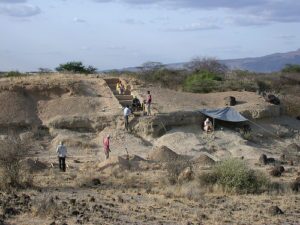
The emergence of long-distance trade, the use of color pigments and the crafting of sophisticated tools all approximately date to the oldest known fossil record of Homo sapiens and occur tens of thousands of years earlier than previous evidence has shown in eastern Africa. Hoping to understand what might have driven such fundamental changes in human behavior, the research team integrated data from a variety of sources to assess and reconstruct the ancient environment in which the users of these artifacts lived. Their findings suggest that the period when these behaviors emerged was one of changing landscapes and climate, in which the availability of resources would have been unreliable. At this Olorgesailie Basin excavation site, the Smithsonian team discovered key artifacts and pigments. Fossil bones found at the site also showed that a significant change in the kinds of animals in this region occurred around the same time as the transitions in human behavior. This turnover signaled that environmental conditions significantly changed and affected which animals could thrive in the region.From news release article, Scientists discover evidence of early human innovation, pushing back evolutionary timeline, March 17, 2018. Human Origins Program, Smithsonian
________________________________
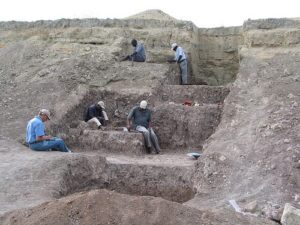
Geological, geochemical, paleobotanical and faunal evidence from the Olorgesailie Basin indicates that an extended period of climate instability affected the region beginning around 360,000 years ago, at the same time earthquakes were continually altering the landscape. Although some researchers have proposed that early humans evolved gradually in response to an arid environment, Potts said his team’s findings support an alternative idea. Environmental fluctuations would have presented significant challenges to inhabitants of the Olorgesailie Basin, prompting changes in technology and social structures that improved the likelihood of securing resources during times of scarcity. In this Olorgesailie Basin excavation site, red ochre pigments were found with Middle Stone Age artifacts. The light brown and gray layers provide evidence of ancient soils and of landscapes affected by earthquakes and other seismic activity, factors that rapidly altered the environment and resources on which human ancestors depended for survival.From news release article, Scientists discover evidence of early human innovation, pushing back evolutionary timeline, March 17, 2018. Human Origins Program, Smithsonian
__________________________________
**Deino et al., Chronology of the Acheulean to Middle Stone Age transition in eastern Africa, Science 360, 95–98 (2018), 6 April 2018.
*** https://popular-archaeology.com/article/on-the-threshold-of-modern-humanity/
****Brooks, et al., Long-distance stone transport and pigment use in the earliest Middle Stone Age, Science 360, 90-94 (2018), 6 April 2018.
*****Potts, et al., Environmental dynamics during the onset of the Middle Stone Age in eastern Africa, Science 10.1126/science.aao2200 (2018).
****** https://popular-archaeology.com/article/rewriting-human-evolution/
________________________________
The Human Origins Field Seminar in Africa: A Unique Travel Opportunity
Join us on this incredible journey!




